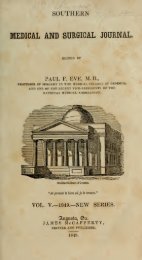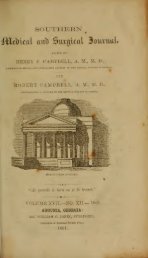—778 On Suppression of the Menstrual Discharge. [November,no conceivable motive existed for deception on the part of eitherhim or his mother. I have, therefore, myself no doubt whateverof the fact I have stated. Both this case <strong>and</strong> the two immediatelypreceding it were communicated at the time to the Border<strong>Medical</strong> Society; so, although the cases occurred many yearsago, I am quite confident of the accuracy of the facts I have detailed.And I hope they may be deemed sufficiently interestingto deserve a place in a more permanent record. [EdinburghMed. Jour., <strong>and</strong> Boston Med. <strong>and</strong> Surg. Jour.Epilepsy succeeding a Suppression of the Menstrual Discharge,Cured bg the Supervention of Dysentery, <strong>and</strong> the Restoration ofthe Catatnenia. By Sampson Eagon, M. D., of Bot. County,Va.Miss T. R, set. 17, had the menstrual function established at15, <strong>and</strong> it continued normally until the 17th year, when fromexposure of the feet to moisture <strong>and</strong> cold at one of the periods,the catamenial discharge was arrested. For several periods shesuffered the ordinary pain <strong>and</strong> discomfort of amenorrhcea, <strong>and</strong>at the fourth month of amenorrhceal suffering, she was attackedwith epilepsy ; I was at this period called to see her. After anunsuccessful effort to re-stablish the catamenial flux, (it being aperiod,) the patient was put upon treatment for epilepsy, thetreatment consisting principally in the use of tonics, antispasmodics,revellents, <strong>and</strong> emmenagogues. The epileptic convulsions,however, continued to recur with undiminished violence,notwithst<strong>and</strong>ing the treatment was assiduously persevered infor more than twelve months. The argent, nitras, several ofthe salts of iron <strong>and</strong> copper, as well as sulphate of quinia, weregiven a fair trial, but without decided benefit.The paroxysms in this case were of the most violent character,<strong>and</strong> lasted for several hours, night <strong>and</strong> morning of eachday. After having fairly tested the virtues of the most popularanti-epileptic means in the case, with so little success, Dr.Woodson, (the consulting physician,) <strong>and</strong> myself ab<strong>and</strong>oned allhope of relieving her. In July, 1858, dysentery became epidemicin her locality, with which disease she was attacked in asevere form. Having been called again to the patient at thisperiod, <strong>and</strong> hoping now that the constant tenesmus <strong>and</strong> irritationof the large intestine might extend by contiguous sympathyto the torpid uterus, I was careful not to arrest the dysentericdischarge too hastily, prescribing only a half grain of opium,with two of the mild chloride of mercury, repeated every eighthours. On the second day, I learned from the patient's mother,that the menstrual discharge was regularly flowing, <strong>and</strong> I found
——;1859.] After-treatment of the Extraction of Cataract. 779the young lady free from epileptic symptoms. The dysenterysoon subsided, <strong>and</strong> the young lady quickly returned to almostperfect health, <strong>and</strong> is now quite well. The only means thathave since been employed in the treatment, have been a prettyactive purgative of aloes <strong>and</strong> rhubarb, conjoined with a warmhip-bath, used for several nights before each expected return.There are two points of interest, as I conceive, in the caseabove detailed : 1st. The undoubted relation which here existedbetween the amenorrhoea <strong>and</strong> epilepsy as cause <strong>and</strong> effect ; <strong>and</strong>2nd. The means employed by nature to produce relief, an irritationpropagated from the rectum <strong>and</strong> colon to the uterus bycontiguous sympathy. [American <strong>Journal</strong>.After-treatment of the Extraction of Cataract.The old method of b<strong>and</strong>aging the eyes is never practiced in theCentral London Ophthalmic Hospital, <strong>and</strong> the modern one ofplastering the eyelids is adopted in its stead. The object is tokeep the eyelids motionless <strong>and</strong> closed, in order that the edgesof the wound in the cornea may be kept in accurate adaptationby the gentle pressure of the eyelids. If a patient can keep hiseyes shut, no appliance is needed ; but few can do this. As theb<strong>and</strong>ages are ordinarily applied, they are useless. To makethem potent as b<strong>and</strong>ages, would dem<strong>and</strong> a degree of pressurethat must be injurious. Very much annnoyance is often producedfrom the cloth being stuck to the cheek, by the aqueoushumor when it trickles away ;<strong>and</strong> the night's rest is broken inconsequence. A couple of straps of court-plaster, the eighth ofan inch wide, accomplish all that is desired. Mr. Walton generallyallows them to remain for a week ;but if any unpleasantnessis complained of, such as stiffness or hardness, theyare removed after the third or fourth da}\ To this plan, whichis wholly unobjectionable, Mr. Walton attaches much value<strong>and</strong> he is convinced that the highest attainable results from theoperation of extraction cannot be obtained without it. Healways keeps the eyelids closed till the aqueous humor no longerescapes from the corneal wound ;that is, till the cornea is quitehealed. At the end of the week, when the patient has openedthe eye, Mr. Walton does not raise the lid himself, but desiresthe patient to open the eye naturally, which he considers farpreferable ; he again closes it, if requisite, with court-plaster forsome days. There can be no doubt of the prudence of this.Many an instance of prolapse of the iris, with all the irritation<strong>and</strong> ulterior consequences, has been produced by the use of theeye before there has been proper reunion. Young operatorsare often sadly puzzled to account for the secondary imperfeotion of prolapse of the iris, after they have had such promisingjr. 8.vol. xv. no. xi. 55
- Page 1 and 2:
SOUTHERNMEDICAL AND SUBGICAL JOURNA
- Page 3 and 4:
1859.] Climate to the Consumptive,
- Page 5 and 6: 1859.] Climate to the Consumptive,
- Page 7 and 8: Aug.Oct.1859.] Climate to the Consu
- Page 9 and 10: 1859.] Climate to the Consumptive,
- Page 11 and 12: 1859.] Climate to the Consumptive,
- Page 13 and 14: 1S59.] Climate to tJte Consumptive,
- Page 15 and 16: 1859.] Climate to l/ie Consumptive,
- Page 17 and 18: 1859.] Climate to the Consumptive,
- Page 19 and 20: 1859.] Climate to the Consumptive,
- Page 21 and 22: 1859.] Dugas, on Fracture of Hie Sc
- Page 23 and 24: 1869.] Lecture upon Cerebral Fever.
- Page 25 and 26: • of1859.] Lecture on Cerebral Fe
- Page 27 and 28: 1859.] Lecture on Cerebral Fever. 7
- Page 29 and 30: 1859.] Lecture on Cerebral Fever. 7
- Page 31 and 32: 1859.] Lecture on Gerebral J' 753un
- Page 33 and 34: 1859.] Lecture on Cerebral Ftthey a
- Page 35 and 36: :1859.] Attempted Abortion and Deat
- Page 37 and 38: 1859.] Attempted Abortion and Death
- Page 39 and 40: :—:1859.] Diphtheria. 761by its o
- Page 41 and 42: —:1859.] Diphtheria. 763ride of i
- Page 43 and 44: ——1859.] Diarrhoea of Infants a
- Page 45 and 46: 1859.] Action of Mercury on the Sec
- Page 47 and 48: 1859.] Defective Assimilation in In
- Page 49 and 50: —1859.] Cancerous Ulceration clos
- Page 51 and 52: —1859.] Vegetation of the Genital
- Page 53 and 54: 1859.] Gases of Suppression of the
- Page 55: 1859.] Cases of Suppression of the
- Page 59 and 60: 1859.] Dr. 0. C. Gibbs. Summary. 78
- Page 61 and 62: 1859.] Dr. 0. C. GrBBS. Summary, 78
- Page 63 and 64: :;1859.] Secale Cornulam for t?ie E
- Page 65 and 66: 1859.] Divisions for the Cure of De
- Page 67 and 68: ;1859.] Incision in Anthrax. 789Inc
- Page 69 and 70: :;1859.] Editorial and Miscellaneou
- Page 71 and 72: ———and1859.] Miscellaneous. 7








